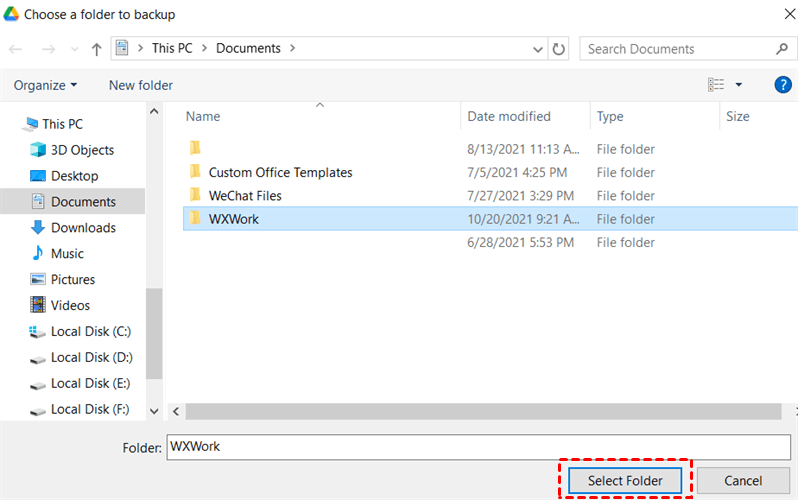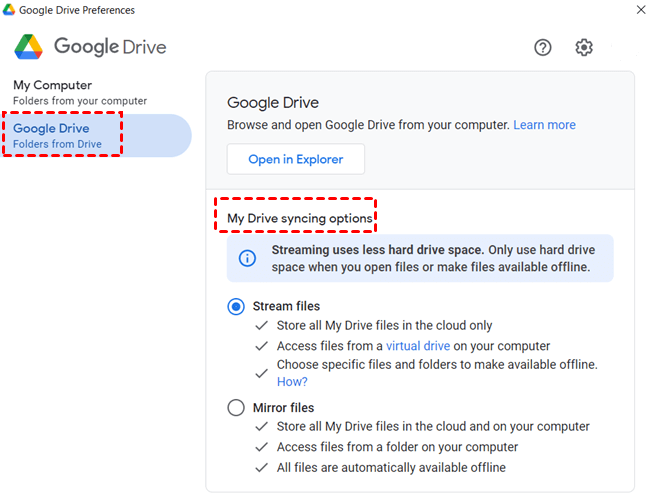Quick Search:
User Case: How to Sync Google Drive to PC Folder?
How to sync a folder from my computer with Google Drive?
- Question from Reddit
How to sync an existing Google Drive folder with an existing local folder?
- Question from Google Community
Understanding Google Drive Sync
What Does “Sync” Actually Mean?
In simple terms, syncing means keeping your files updated across two locations—in this case, Google Drive’s cloud and a folder on your local computer. Any changes you make in one spot reflect in the other, like magic.
Difference Between Sync and Backup
People often confuse sync with backup. Sync is two-way: change a file on your computer, and it updates in the cloud (and vice versa). Backup is one-way: your files are stored in the cloud, but changes don’t reflect automatically.
Benefits of Syncing Google Drive with a Local Folder
Google Drive is Google’s cloud storage service that lets you store files online and access them from any device. Whether you’re saving photos, documents, or entire folders, Google Drive has your back.
Easy Access to Files
No need to launch a browser every time. Your files are available right in your computer’s file explorer. It’s like having Google Drive as part of your hard drive.
Offline Availability
No Wi-Fi? No problem. Files synced locally can be accessed and edited even when you’re offline. Once you reconnect, everything updates.
Real-Time Updates
Whether you're working solo or collaborating with a team, changes made in real-time sync almost instantly across devices.
Step-by-Step Guide to Google Drive Local Folder Sync
Google Drive offers a nifty tool called Google Drive for Desktop. This app bridges the gap between cloud and computer.
Step 1: Download Google Drive for Desktop
Head to the Google Drive download page and grab the installer for your OS.
Step 2: Install and Sign In
Follow the installation instructions, then log into your Google account when prompted.
Step 3: Choose Folders to Sync
During setup, pick the folders from your PC to sync with Drive. Then, choose which folders from Drive to sync to your local device.
Step 4: Customize Sync Settings
You can choose:
- Stream files (saves local space—only downloads when opened)
- Mirror files (local copies of everything in Drive)
Step 5: Verify the Sync
Once setup is complete, open the synced folder on your PC and check that files from your Google Drive appear. Make a change to a file—see it update in the cloud!
Advanced Google Drive Local Folder Sync Options
Sync Only Specific File Types
Want to exclude huge video files or system files? No problem. Under "Advanced", you can create filters by file type or size.
Pause and Resume Sync
Need to save bandwidth? You can pause sync from the taskbar icon and resume it anytime.
Sync Multiple Google Accounts
Got a work and personal account? Google Drive for Desktop supports multiple logins—just toggle between them in the app. >> Look here to learn more ways to llink multiple Google Drive accounts.
Troubleshooting Common Sync Issues
1. Sync Not Working? Try This
- Restart the app.
- Make sure you're online.
- Check if Drive is down at Google's status page.
2. Missing Files or Folders
Files not showing? Ensure the folder is selected in your sync settings.
3. Conflicts and Duplicates
Google Drive may create versions of files if you make changes on multiple devices. To avoid this:
- Sync from only one device at a time.
- Avoid renaming files in multiple places.
4. Storage Limitations
Ran out of space? Google offers 15GB for free, but you can upgrade through Google One for more room. Or, look here to find other ways to get more Google Drive storage.
Tips for a Smooth Sync Experience
Best Practices for File Naming and Structure
Keep things tidy:
- Avoid spaces or special characters.
- Use consistent folder names.
- Stick to lowercase letters for simplicity.
Trust me, future-you will thank you.
How to Handle Large File Uploads
Large files? Here’s what works:
- Use Wi-Fi, not mobile data.
- Split huge files into parts.
- Sync overnight or during off-peak hours.
Conclusion
Syncing your Google Drive with a local folder is like giving your computer a direct hotline to the cloud. It makes working faster, smarter, and more flexible. Whether you're a casual user or a productivity ninja, mastering this feature can transform how you handle files. So go ahead—sync up and level up!
Bonus Tip: Best Way to Move Google Drive Data to Other Clouds?
If you're looking for the most efficient and hassle-free way to move your Google Drive data to other cloud storage platforms, MultCloud stands out as the best solution. This powerful cloud management service lets you transfer, sync, or back up files across different cloud drives like Dropbox, OneDrive, MEGA, and more—all in one place, without the need to download and re-upload files manually.
With its user-friendly interface, support for scheduled transfers, and secure OAuth authorization, MultCloud simplifies cloud-to-cloud migration, making it ideal for both personal and professional use.

- Perfect Integration: Manage up to 30+ cloud drives centrally.
- Random Migration: Do one-time or incremental migration according to your own needs.
- Real-time Sync: Provide 10 custom sync modes to simplify collaboration.
- Smart Backup: Restore the backed-up data to the previous version at any time.
- Image Saver: Free to save images or videos to local devices or cloud accounts.
- Email Migration: Easily save emails and attachments to all kinds of cloud drives.
- Remote Upload: Directly download URLs, torrent files or magnet links to cloud drives.
MultCloud Supports Clouds
-
Google Drive
-
Google Workspace
-
OneDrive
-
OneDrive for Business
-
SharePoint
-
Dropbox
-
Dropbox Business
-
MEGA
-
Google Photos
-
iCloud Photos
-
FTP
-
box
-
box for Business
-
pCloud
-
Baidu
-
Flickr
-
HiDrive
-
Yandex
-
NAS
-
WebDAV
-
MediaFire
-
iCloud Drive
-
WEB.DE
-
Evernote
-
Amazon S3
-
Wasabi
-
ownCloud
-
MySQL
-
Egnyte
-
Putio
-
ADrive
-
SugarSync
-
Backblaze
-
CloudMe
-
MyDrive
-
Cubby



